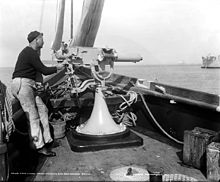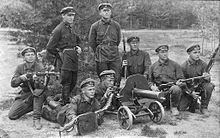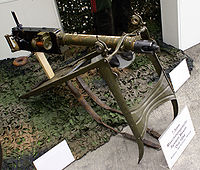| Maxim gun | |
|---|---|
Maxim gun, Georgian national museum | |
| Type | Heavy Machine Gun |
| Place of origin | United Kingdom |
| Service history | |
| In service | 1889-1950s |
| Used by | |
| Wars | Second Boer War, Mahdist War, Dervish Resistance, First Sino-Japanese War, Boxer Rebellion, Russo-Japanese War, Finnish Civil War, Balkan Wars, World War I, Russian Civil War, Second Sino-Japanese War, Polish-Soviet War, World War II, Chinese Civil War, Korean War |
| Production history | |
| Designer | Sir Hiram Stevens Maxim |
| Variants | Vickers machine gun, MG08, PM M1910, M32-33, M/09-21 |
| Specifications | |
| Weight | 27.2 kg |
| Length | 107.9cm |
| Barrel length | 67.3cm |
| Crew | four man crew |
| | |
| Cartridge | .303 British |
| Action | Recoil-operated |
| Rate of fire | 500 rounds/min |
| Muzzle velocity | 744 m/s |
| Feed system | 250-round canvas belt |
The Maxim gun was the first recoil-operated machine gun, invented by the American-born[1] British inventor Sir Hiram Stevens Maxim in 1884. It has been called "the weapon most associated with [British] imperial conquest".[2]
Functionality
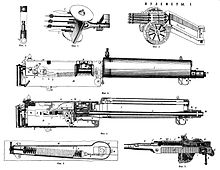
The mechanism of the Maxim gun employed one of the earliest recoil operated firing systems in history. The idea is that the energy from the recoil is used, in lieu of a locked bolt or a lever mechanism, to eject each spent cartridge and insert the next one. This made it vastly more efficient and less labour intensive than previous rapid-firing guns, such as the Gatling, Gardner, or Nordenfelt guns that relied on actual mechanical cranking, as well as decreasing the gas buildup in the barrel, allowing the gun to fire more bullets over an extended period of time without overheating the barrel. The Maxim gun design still required water cooling, however, which gave it additional points of failure and made it more difficult to operate and heavier per calibre, compared to most later heavy machine guns. Trials demonstrated the Maxim could fire 600 rounds per minute,[3] equivalent to the firepower of about 30 contemporary bolt-action rifles. Compared to modern machine guns, the Maxim was heavy, bulky, and awkward. Although a lone soldier could fire the weapon, it was usually operated by a team of men. Apart from the gunner, other crew were needed to speed reload, spot targets, and carry and ready ammunition and water. Several men were needed to move the heavy weapon and mounting.
Production company
Maxim established the Maxim Gun Company with financing from Albert Vickers, son of steel entrepreneur Edward Vickers. A blue plaque on the Factory where Maxim invented and produced the gun is to be found in Hatton Garden at the junction with Clerkenwell Road in London.
Albert Vickers became the company's chairman, and it later joined hands with a Swedish competitor, Nordenfelt, to became Maxim Nordenfelt Guns and Ammunition Company. The Post Office Directory of trades in London of 1895 lists its office at 32 Victoria Street SW (London) on page 1579.
Finally, the company was absorbed into the mother Vickers company, leading first to the Maxim-Vickers gun and then, after Vickers' redesign, the Vickers machine gun.
History
Development (1883–1884)
Maxim's first patents related to the development of the Maxim were registered in June and July 1883.[4] The first prototype was demonstrated to invited guests in October 1884.[5]
Use in colonial warfare (1884–1914)
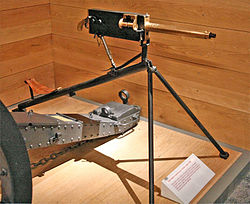
A prototype of the Maxim gun was given by Hiram Maxim to the Emin Pasha Relief Expedition in 1886–1890, under the leadership of Henry Morton Stanley. More a publicity stunt than a serious military contribution, in view of the main financier of the expedition, William Mackinnon, "merely exhibiting" the gun was likely to "prove a great peace-preserver".[6] And in fact the gun was used on several occasions, especially during the expedition's retreat from central Africa, not because of its devastating effects, but as an effective means to scare off native attackers. The same prototype was brought back to central Africa by Frederick Lugard, where it played an instrumental role in the establishment of a British protectorate over present-day Uganda (then Buganda), which is a strong testament to the sturdiness and reliability of the weapon and its prototype.[7]
The first unit in the world to receive the Maxim was the Singapore Volunteer Corps in 1889. This was a civilian volunteer defence unit on the then-British island.
The Maxim gun was first used by Britain's colonial forces in the 1893–1894 First Matabele War in Rhodesia. During the Battle of the Shangani, 700 soldiers fought off 3,000 warriors with just four Maxim guns. It played an important role in the swift European colonization of Africa in the late 19th century. The extreme lethality was employed to devastating effect against obsolete charging tactics, when native opponents could be lured into pitched battles in open terrain. As it was put by Hilaire Belloc, in the words of the figure "Blood" in his poem "The Modern Traveller":
- Whatever happens, we have got
- The Maxim gun, and they have not. [8]
However, the destructive power of the Maxim gun in colonial warfare has often been overegged by popular myth. Modern historical accounts suggest that, while it was effective in pitched-battle situations such as the Matabele war or the 1898 Battle of Omdurman, its significance owed much to the psychological impact the weapon had.
A larger-calibre version of the Maxim, firing a one-pound shell, was built by Maxim-Nordenfeldt. This was known in the Second Boer War (in South Africa) as the Pom-Pom from its sound and was used on both sides. The Maxim gun was also used in the Anglo-Aro War (in present day Nigeria) of 1901–1902.
National and military authorities were reluctant to adopt the weapon, and Maxim's company initially had some trouble convincing European governments of the weapon's efficiency. Soldiers generally held a great mistrust of machine guns due to their tendency to jam. In the 1906 version of the book Small Wars the author says of machine guns: "The older forms are not suitable as a rule... they jammed at Ulundi, they jammed at Dogali, they jammed at Abu Klea and Tofrek, in some cases with unfortunate results."[9] The Maxim was significantly more reliable than its contemporaries, however.[10] A more practical problem was that, initially, its position was easily given away by the clouds of smoke the gun produced. The advent of smokeless powder (developed by, among others, Hiram's brother Hudson Maxim), helped to change this.
The weapon was adopted by the British Army under the guidance of Sir Garnet Wolseley, who had been appointed Commander-in-Chief of the British Army in 1888. In October that year he placed an order of 120 rifle-calibre Maxims[11] using the same .577/450 ammunition as the Martini-Henry rifles. Wolseley had previously led military excursions in Africa (the Ashanti war and the Gordon Relief Expedition in 1884–85), and had a reputation for being a strong subscriber to military innovation and reform, which he demonstrated in Africa. There he used machine guns, explored other unconventional ideas, and founded an Egyptian camel corps.
The gun's design was also purchased and used by several other European countries. The Maxim gun saw action in the Russo-Japanese War, where it was employed by the Imperial Russian Army.[12]
World War I (1914–1918)
By World War I, many armies had moved on to improved machine guns. The British Vickers machine gun was an improved and redesigned Maxim, introduced into the British Army in 1912 and remaining in service until 1968. Production took place at Erith in Kent and some models were fitted to early biplanes also fabricated there. The German Army's Maschinengewehr 08 and the Russian Pulemyot Maxim were both more or less direct copies of the Maxim.
It also saw use during the Russian Civil War which followed the Revolution in 1917. A picture of the period depicts a Maxim gun mounted on a tachanka, a horse-drawn carriage, along with the gunner, firing backwards at a pursuing White Army regiment. Anarchists attribute this mobile setup to Nestor Makhno. Some socialist realist propaganda art features Vladimir Lenin manning the gun himself, but it is very unlikely that he ever did so.
Maxim gun variants and derivatives
- Maxim 5 barrel machine gun, 5 barrel variant fed from overhead inserted magazines and later belt feed.
- Vickers machine gun: earlier Maxims had been chambered for earlier British service cartridges, but the Vickers was produced for export available in most of the different calibres and cartridges used by countries around the world, and including a large caliber (.50 inch) as used on Royal Navy warships. The machine gun was twenty pounds lighter and had been tested by the Army in 1909.[13]
- Maschinengewehr 01, made by Deutsche Waffen und Munitionsfabriken (DWM)
- MG 08
- Derivatives (e.g., MG08/15)
- Maschinengewehr Modell 1911, made by Waffenfabrik Bern
- Russian/Soviet Pulemyot Maxima PM1910 and lighter variants Maxim–Tokarev and PV-1 machine gun
- Chinese Type 24 Heavy Machine Gun (Copies of the Commercial 1909)
- Finnish Maxim M/09-21
- The Maxim gun also popularized tripods and belt-feed. Earlier machine guns were usually mounted on horse carriages like small artillery pieces and fed from a hopper.
See also
- QF 1 pounder pom-pom
- Caldwell machine gun
- Kjellman machine gun
- M1917 Browning machine gun
- Nordenfelt gun
- Perino Model 1908
- Fittipaldi machine gun
- Hotchkiss machine gun
- St. Étienne Mle 1907
References
- ^ Encyclopedia Britannica: Sir Hiram Stevens Maxim
- ^ Gilbert, Martin (1997), A History of the Twentieth Century: Volume One; 1900–1933 (1st US ed. ed.), New York: William Morrow and Company, p. 11, ISBN 0-688-10064-3
- ^ Stevenson, David (2004). 1914–1918: The History of the First World War. Penguin Books. p. 8. ISBN 0-14-026817-0.
- ^ McCallum, pg 46
- ^ McCallum, pg 49
- ^ Iain R. Smith : The Emin Pasha Relief Expedition, p. 86
- ^ Blaabjerg, Morten (2007), Uhyret der sagde puh! puh! Maxim maskingeværets logistik i det mørkeste Afrika, fra Gordons fald til slaget ved Omdurman 1885–1898 (in Danish), University of Southern Denmark
- ^ The Modern Traveller colonialwargaming.co.uk
- ^ Callwell, pg 440
- ^ Small Wars. 1906. Callwell, pg 559
- ^ McCallum, pg 67
- ^ Gilbert, Martin. Pg 93
- ^ Graham, Dominick (December 1982). "The British Expeditionary Force in 1914 and the Machine Gun". Military Affairs 46: 190–193.
Further reading
- Anon, Vickers, Sons and Maxim Limited: Their Works and Manufactures. (Reprinted from 'Engineering') London (1898). It gives plates showing the mechanism of the Vickers Maxim gun and numerous plates showing the variety of mounts available at the end of the 19th century. It also includes numerous plates of the factories in which they were made.
- Callwell, Colonel C.E. (1990). Small Wars, a Tactical Textbook for Imperial Soldiers. London: Greenhill Books. ISBN 1-85367-071-5. This is a reprint of the 1906 version.
- Chivers, C. J. (2010). The Gun. Simon & Schuster. ISBN 978-0-7432-7076-2. (See chapter 3: "Hiram Maxim Changes War")
- Ferguson, Niall (2004). Empire. Penguin Books. ISBN 0-14-100754-0.
- Goldsmith, Dolf F. (1989). The Devil's Paintbrush. Sir Hiram Maxim's Gun. Collector Grade Publications, Toronto. ISBN 0-88935-056-6.
- McCallum, Iain (1999). Blood Brothers. Hiram and Hudson Maxim: Pioneers of Modern Warfare. London: Chatham Publishing. ISBN 1-86176-096-5.
- Ellis, John (1976). The Social History of the Machine Gun. London: Pimlico.
External links
| ||||||||||||||||||||
